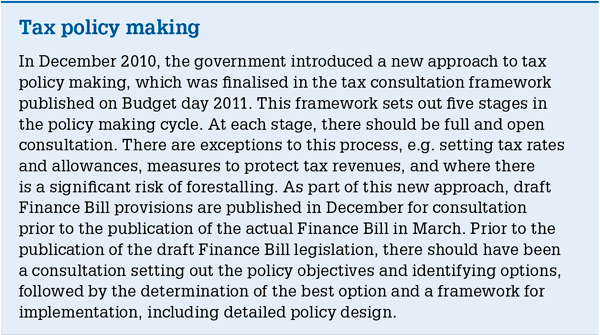The House of Lords Finance Bill Sub-Committee (FBSC) recently reported on the draft Finance Bill measures dealing with the taxation of partnerships and the extent to which they are consistent with the new approach to tax policy making. The report recommended that legislation should be drafted as precisely as possible to reduce reliance on guidance and emphasised the importance of establishing a clear policy objective before new legislation is drafted. This recommendation has not been adopted in respect of the salaried members rules in the Finance Bill, which are largely unchanged from those published on 7 March 2014 and thus fail to address the wide-ranging criticisms made thereof.
Jeanette Zaman and Zoe Andrews write that the recent changes to the partnerships tax rules highlight an increasing trend for loosely drafted, wide-reaching legislation that requires reliance on detailed guidance to identify its actual anti-avoidance targets
 The taxation of partnerships is an area which is in need of, and has been receiving, considerable attention. The UK does not have a separate system for the taxation of partnerships (unlike, for example, the US).
The taxation of partnerships is an area which is in need of, and has been receiving, considerable attention. The UK does not have a separate system for the taxation of partnerships (unlike, for example, the US).
The general ‘look-through’ approach of not taxing the partnership itself but taxing/relieving the partners on their share of the partnership’s profits and losses can cause problems in practice, particularly where a partner joins or leaves a partnership, or in an international context (e.g. in applying tax treaties).
 Ideally, there would be a single coherent package addressing all aspects of the reform of the taxation of partnerships. In practice, however, the perceived problems are being tackled in a piecemeal way.
Ideally, there would be a single coherent package addressing all aspects of the reform of the taxation of partnerships. In practice, however, the perceived problems are being tackled in a piecemeal way.
Tackling the big picture is the Office of Tax Simplification (OTS), which is carrying out a general review of the taxation of partnerships and has already submitted an interim report (Review of partnerships: interim report), to which the government responded in the Budget by agreeing to implement some of the recommended short‑term fixes.
Zoning in on particular aspects as a matter of priority for the exchequer, the Finance (No.2) Bill 2014 (the Finance Bill) brings in several changes to the taxation of partnerships to tackle perceived avoidance, including the controversial ‘salaried members’ in LLPs rules.
In parallel, as part of the ongoing review of the taxation of loan relationships and derivative contracts, HMRC considered making changes to simplify and clarify the way these rules deal with partnerships, and transactions between partners and partnerships, in this same Finance Bill. This has proved to be a more complex task than originally expected, so these changes have been delayed until Finance Bill 2015.
The OTS’s overall conclusion in its interim report is that ‘partnership tax works, but like a comfortable old shoe it is a little worn at the edges and may have a couple of holes coming through’. The amount of work required to produce a separate Partnerships Tax Act and the upheaval and uncertainty involved in moving towards such a system have led the OTS to conclude that it should instead improve and simplify what we already have. The OTS suggests that the tax system needs to take a more strategic approach to partnerships (rather than partnerships being an afterthought) and HMRC should be more coordinated in this area.
In response to the interim report, the Budget materials include a statement that the government will publish a draft consolidated Partnership Tax Manual for comment in April 2014, linking all HMRC partnership guidance. Furthermore, various aspects of the HMRC guidance will be revised to take on board specific suggestions of the OTS.
An interesting, yet worrying, theme identified by the OTS is an apparently widely held view (even amongst some junior HMRC staff) that HMRC generally treats partnerships, and LLPs in particular, as if they were exclusively avoidance vehicles. And this leads us nicely on to the provisions on partnerships in the Finance Bill.
Part 1 of Schedule 13 of the Finance Bill (as published on 27 March 2014) introduces the LLPs: treatment of salaried members rules. These will apply with effect from 6 April 2014 (thus rejecting the recommendation of the Finance Bill Sub-Committee of the House of Lords Economic Affairs Committee (the FBSC) that these rules be postponed until 2015). Disappointingly, the legislation itself is unchanged in any material respect since the draft clauses published on 7 March 2014. A revised technical note and guidance on the salaried member rules (also published on 27 March 2014) incorporates further comments and examples received after publication of the 21 February version of the guidance. It is difficult to avoid noting that there are eight pages of legislation in the Finance Bill on this subject, but the guidance on how this legislation should be applied now runs to 63 pages.
The new rules, which remove the current presumption of self-employment for members of an LLP and introduce a statutory test, have been much written about (and much criticised) (see, for example, ‘FB 2014: Partnerships’ (James McCredie)). One of the (many) criticisms of the salaried members rules is that they put UK LLPs at a disadvantage to general partnerships, limited partnerships and non-UK LLPs, none of which will be subject to the new rules. These partnerships will remain subject to the case law test of whether a partner or member is self-employed or an employee. But the government does not seem to consider this a problem, perhaps because of its tainted view that those choosing to use a UK LLP (rather than a general or limited partnership structure) must be trying to avoid tax, rather than simply taking advantage of the more limited liability the LLP structure affords them over another type of partnership. Indeed, the explanatory notes to the relevant clauses state at the outset that the rules ‘tackle the disguising of employment relationships through LLPs’.
The Law Society has been one of several bodies lobbying for these widely drafted rules to be refined (and has published a practice note written for solicitors who are members of LLPs that explains the practical detail of the new rules; see www.lexisurl.com/BdMfG).
The FBSC examined the measures in the Finance Bill dealing with the taxation of partnerships and the extent to which the development of the partnerships package was consistent with the new approach to tax policy making (see the box above). The FBSC also considered how effectively the new policy making process has been applied to the development of tax legislation since 2011. Its findings were published in a report on 11 March 2014.
The FSBC’s report makes for interesting reading generally, not just in the context of its comments on the salaried members rules. The conclusions and recommendations include those highlighted below. None of these recommendations were in fact picked up in the Finance Bill, but it is hoped the more general recommendations may be borne in mind in the future:
Advisers and taxpayers have been objecting for some years now to the increasing trend for loosely drafted, wide-reaching legislation, which then requires reliance on detailed guidance to narrow its scope – the salaried members rules are a recent example of such trend. It is to be welcomed that the FBSC has recognised that this is not a coherent approach to drafting legislation, but whether it will have any impact on the approach to future Finance Bills remains to be seen.
If, as the FBSC’s report recommends, HMRC is able to identify practices to which it objects earlier, anti-avoidance legislation could be more carefully targeted to catch or deter the ‘bad’ behaviour. But, if anything, HMRC’s approach to anti-avoidance legislation seems to be going the other way; in a desire to future-proof anti-avoidance provisions and afford protection against the ‘unknown unknowns’, we are likely to see more provisions which cast the net widely and then seek to rely on guidance to reassure the ‘innocent’ that they will not suffer.

The House of Lords Finance Bill Sub-Committee (FBSC) recently reported on the draft Finance Bill measures dealing with the taxation of partnerships and the extent to which they are consistent with the new approach to tax policy making. The report recommended that legislation should be drafted as precisely as possible to reduce reliance on guidance and emphasised the importance of establishing a clear policy objective before new legislation is drafted. This recommendation has not been adopted in respect of the salaried members rules in the Finance Bill, which are largely unchanged from those published on 7 March 2014 and thus fail to address the wide-ranging criticisms made thereof.
Jeanette Zaman and Zoe Andrews write that the recent changes to the partnerships tax rules highlight an increasing trend for loosely drafted, wide-reaching legislation that requires reliance on detailed guidance to identify its actual anti-avoidance targets
 The taxation of partnerships is an area which is in need of, and has been receiving, considerable attention. The UK does not have a separate system for the taxation of partnerships (unlike, for example, the US).
The taxation of partnerships is an area which is in need of, and has been receiving, considerable attention. The UK does not have a separate system for the taxation of partnerships (unlike, for example, the US).
The general ‘look-through’ approach of not taxing the partnership itself but taxing/relieving the partners on their share of the partnership’s profits and losses can cause problems in practice, particularly where a partner joins or leaves a partnership, or in an international context (e.g. in applying tax treaties).
 Ideally, there would be a single coherent package addressing all aspects of the reform of the taxation of partnerships. In practice, however, the perceived problems are being tackled in a piecemeal way.
Ideally, there would be a single coherent package addressing all aspects of the reform of the taxation of partnerships. In practice, however, the perceived problems are being tackled in a piecemeal way.
Tackling the big picture is the Office of Tax Simplification (OTS), which is carrying out a general review of the taxation of partnerships and has already submitted an interim report (Review of partnerships: interim report), to which the government responded in the Budget by agreeing to implement some of the recommended short‑term fixes.
Zoning in on particular aspects as a matter of priority for the exchequer, the Finance (No.2) Bill 2014 (the Finance Bill) brings in several changes to the taxation of partnerships to tackle perceived avoidance, including the controversial ‘salaried members’ in LLPs rules.
In parallel, as part of the ongoing review of the taxation of loan relationships and derivative contracts, HMRC considered making changes to simplify and clarify the way these rules deal with partnerships, and transactions between partners and partnerships, in this same Finance Bill. This has proved to be a more complex task than originally expected, so these changes have been delayed until Finance Bill 2015.
The OTS’s overall conclusion in its interim report is that ‘partnership tax works, but like a comfortable old shoe it is a little worn at the edges and may have a couple of holes coming through’. The amount of work required to produce a separate Partnerships Tax Act and the upheaval and uncertainty involved in moving towards such a system have led the OTS to conclude that it should instead improve and simplify what we already have. The OTS suggests that the tax system needs to take a more strategic approach to partnerships (rather than partnerships being an afterthought) and HMRC should be more coordinated in this area.
In response to the interim report, the Budget materials include a statement that the government will publish a draft consolidated Partnership Tax Manual for comment in April 2014, linking all HMRC partnership guidance. Furthermore, various aspects of the HMRC guidance will be revised to take on board specific suggestions of the OTS.
An interesting, yet worrying, theme identified by the OTS is an apparently widely held view (even amongst some junior HMRC staff) that HMRC generally treats partnerships, and LLPs in particular, as if they were exclusively avoidance vehicles. And this leads us nicely on to the provisions on partnerships in the Finance Bill.
Part 1 of Schedule 13 of the Finance Bill (as published on 27 March 2014) introduces the LLPs: treatment of salaried members rules. These will apply with effect from 6 April 2014 (thus rejecting the recommendation of the Finance Bill Sub-Committee of the House of Lords Economic Affairs Committee (the FBSC) that these rules be postponed until 2015). Disappointingly, the legislation itself is unchanged in any material respect since the draft clauses published on 7 March 2014. A revised technical note and guidance on the salaried member rules (also published on 27 March 2014) incorporates further comments and examples received after publication of the 21 February version of the guidance. It is difficult to avoid noting that there are eight pages of legislation in the Finance Bill on this subject, but the guidance on how this legislation should be applied now runs to 63 pages.
The new rules, which remove the current presumption of self-employment for members of an LLP and introduce a statutory test, have been much written about (and much criticised) (see, for example, ‘FB 2014: Partnerships’ (James McCredie)). One of the (many) criticisms of the salaried members rules is that they put UK LLPs at a disadvantage to general partnerships, limited partnerships and non-UK LLPs, none of which will be subject to the new rules. These partnerships will remain subject to the case law test of whether a partner or member is self-employed or an employee. But the government does not seem to consider this a problem, perhaps because of its tainted view that those choosing to use a UK LLP (rather than a general or limited partnership structure) must be trying to avoid tax, rather than simply taking advantage of the more limited liability the LLP structure affords them over another type of partnership. Indeed, the explanatory notes to the relevant clauses state at the outset that the rules ‘tackle the disguising of employment relationships through LLPs’.
The Law Society has been one of several bodies lobbying for these widely drafted rules to be refined (and has published a practice note written for solicitors who are members of LLPs that explains the practical detail of the new rules; see www.lexisurl.com/BdMfG).
The FBSC examined the measures in the Finance Bill dealing with the taxation of partnerships and the extent to which the development of the partnerships package was consistent with the new approach to tax policy making (see the box above). The FBSC also considered how effectively the new policy making process has been applied to the development of tax legislation since 2011. Its findings were published in a report on 11 March 2014.
The FSBC’s report makes for interesting reading generally, not just in the context of its comments on the salaried members rules. The conclusions and recommendations include those highlighted below. None of these recommendations were in fact picked up in the Finance Bill, but it is hoped the more general recommendations may be borne in mind in the future:
Advisers and taxpayers have been objecting for some years now to the increasing trend for loosely drafted, wide-reaching legislation, which then requires reliance on detailed guidance to narrow its scope – the salaried members rules are a recent example of such trend. It is to be welcomed that the FBSC has recognised that this is not a coherent approach to drafting legislation, but whether it will have any impact on the approach to future Finance Bills remains to be seen.
If, as the FBSC’s report recommends, HMRC is able to identify practices to which it objects earlier, anti-avoidance legislation could be more carefully targeted to catch or deter the ‘bad’ behaviour. But, if anything, HMRC’s approach to anti-avoidance legislation seems to be going the other way; in a desire to future-proof anti-avoidance provisions and afford protection against the ‘unknown unknowns’, we are likely to see more provisions which cast the net widely and then seek to rely on guidance to reassure the ‘innocent’ that they will not suffer.








